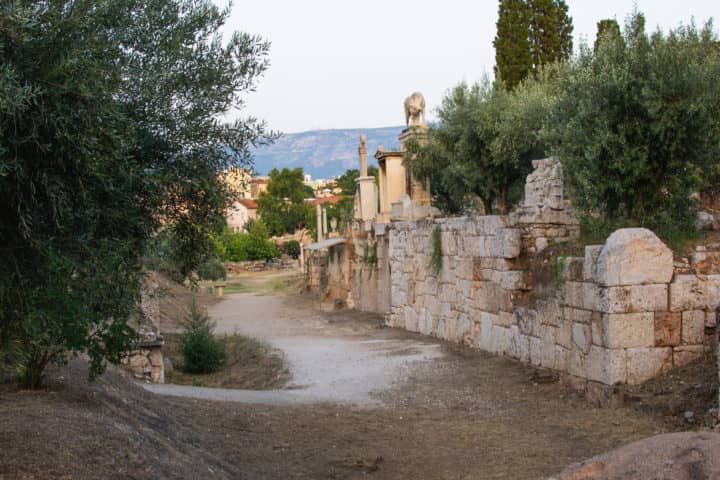 Karameikos is an interesting and unique archeological site near Athens. However, it doesn’t seem to draw the types of crowds that other places, such as the Parthenon, do. This doesn’t make it any less important than those! Kerameikos is an ancient cemetery that dates back to at least 900 B.C. Located next to the burial ground is the Kerameikos Archaeological Museum. The Kerameikos area is also a section of the city of Athens just northwest of the Acropolis. . Most of the artifacts are located in the archaeological museum so even if you don’t visit the site, you should at least visit the museum. Here’s more information:
Karameikos is an interesting and unique archeological site near Athens. However, it doesn’t seem to draw the types of crowds that other places, such as the Parthenon, do. This doesn’t make it any less important than those! Kerameikos is an ancient cemetery that dates back to at least 900 B.C. Located next to the burial ground is the Kerameikos Archaeological Museum. The Kerameikos area is also a section of the city of Athens just northwest of the Acropolis. . Most of the artifacts are located in the archaeological museum so even if you don’t visit the site, you should at least visit the museum. Here’s more information:
About the Kerameikos Archaeological Museum
The museum is located near the end of Ermou Street and close to the intersection of Peiraios Street. The building itself is a small structure of neoclassical design by noted architect H. Johannes. Construction completed in 1936. It houses significant archaeological finds, including funerary columns, statues, vases, funerary urns, toys, jewelry and a variety of other items.
Many of these relics were uncovered in 1836 by the German Archaeological Institute. The Kerameikos Museum is divided into four primary sections. Each walled-off portion is devoted to a specific theme and class of artifacts. Also, an atrium holds a fabulous interior garden graced by olive and bay trees along with a variety of flora native to Attica.
What to Do at the Museum
The museum affords visitors an extraordinary opportunity to view findings from historic periods that cut across numerous artistic styles as they changed and evolved across the centuries. Because the artifacts are derived from funerary implements and traditions they reveal deep insight into the spiritual and religious practices of ancient Greeks. How the ancients confronted death and burial reveals much about how they lived.
The easterns halls contain mounds and steles (monumental stone slabs) of the classical to archaic periods. Exhibited in the south hall are pottery and ritual offering items that date back to prehistory. The western hall also has items of pottery and ceramics of the geometric periods, from late to early eras. These significant examples represent the central characteristics of Attican artistry. The northern section displays a major collection of pottery of the classical period.
Get to Know the Site of Kerameikos
The 40,000 square meters of the Kerameikos cemetery comprises an unparalleled journey through centuries of ancient Greek history and culture. It was functional from the 9th Century B.C. all the way to Roman times.
The word ceramics or pottery is derived from the name Kerameikos. Before the site became a cemetery it was the venue of pottery artisans, craftsman and their workshops. It was a thriving community. It must be noted this location is also associated with the mythological hero, Keramos, said to be the son of the god Dionysus and Cretan Princess Ariadne.
Thus, more than graves, Kerameikos bares the ruins of buildings, temples, pottery shops and many other aspects of Greek culture spanning centuries. It remains among the most important sites in Athens, rich in cultural history, artifacts and architectural ruins.
Viewing the grounds of Kerameikos is a time-traveling experience unlike any other destination in the ancient world.

